Cosmic Curiosities
“We sometimes hear of things that can travel faster than light. Something called 'the speed of thought' is occasionally proffered. This is an exceptionally silly notion, especially since the speed of impulses through the neutrons in our brain is about the same as the speed of a donkey cart.”
- Carl Sagan
The Speed of Thought
How fast does a cheetah go? How quick is the speediest spaceship? Our inquisitive nature is always seeking answers to questions like these. So which is faster: light or a human thought? Let’s look at light first.
Light is insanely fast at 186,000 miles per second, meaning it can race around the Earth 7.5 times each second. Just think, when we wink at someone, it takes about a second; meanwhile, light has done seven-plus laps around our planet. Amazing!
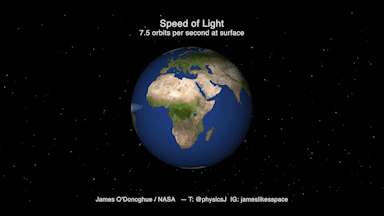 Sure, light slows down when it hits air, glass, or water, but not my much—around 25 percent. It can still zip around the Earth five times every second. And remember: Light’s photons don’t really slow down. When they hit water, for instance, they get absorbed by electrons and re-emitted. These collisions reduce light’s overall speed.
Sure, light slows down when it hits air, glass, or water, but not my much—around 25 percent. It can still zip around the Earth five times every second. And remember: Light’s photons don’t really slow down. When they hit water, for instance, they get absorbed by electrons and re-emitted. These collisions reduce light’s overall speed.
What about human thought? We have these impulses that feel incredibly fast, almost instantaneous. Can our brains process thoughts faster than light? Trying to measure thought is not easy; the human body has 86 billion neurons, or nerve cells. Our brains have a quadrillion synapses. That’s 1,000,000,000,000,000 connections from brain neurons to neurons in the rest of our bodies! That is an amazing array of complex networks for researchers to navigate.
Many experts in this area consider reaction time the best way when measuring speed of thought. A reaction to a sound telling us to move—like the start of a race—takes 0.15 seconds. A “have a cookie or not” decision can take many seconds, even minutes!
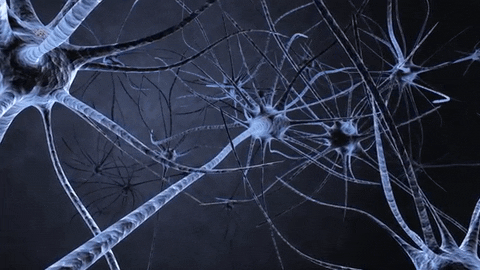 If you do some quick math, you find neurons move more like a snail compared to light. Neurons from the spinal cord to the muscles move about 150 to 250 miles an hour. That’s 0.0000004 percent of the speed of light. Signals going to pain receptors travel even slower at just a few miles an hour.
If you do some quick math, you find neurons move more like a snail compared to light. Neurons from the spinal cord to the muscles move about 150 to 250 miles an hour. That’s 0.0000004 percent of the speed of light. Signals going to pain receptors travel even slower at just a few miles an hour.
How slow does pain travel? If a person stubs their toe, they will often scream “ouch” before they actually feel any pain. It can feel like our impulses move at light speed, but they're not even close to traveling around the entire 7.5 times in one second!
(By the way, a cheetah can run about 60 miles per hour. Our fastest spaceship—the Parker Solar Probe—will go 120 miles per second as orbits closer and closer to the sun.)
The Wonderchicken
We uncovered another curious bit of science news while producing our new DinoSOARS! Planetarium program, a full dome show about how today’s birds are living dinosaurs! A recent and exciting discovery was a very small bird fossil known as Asteriornis, or the Wonderchicken. This tiny bird weighed only one pound. It was a member of a Galloanserae group that gave rise to today’s chickens and ducks.
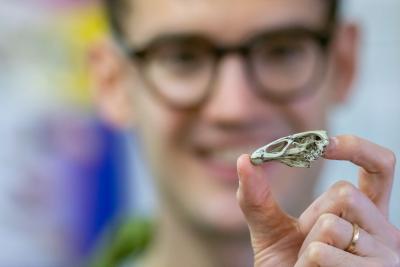 This very tiny bird fossil was discovered in a limestone quarry near the Belgian-Dutch border. Dr. Daniel Field remarked shortly after finding it beneath the rock in 2020 that the skull “is one of the best-preserved fossil bird skulls of any age, from anywhere in the world.”
This very tiny bird fossil was discovered in a limestone quarry near the Belgian-Dutch border. Dr. Daniel Field remarked shortly after finding it beneath the rock in 2020 that the skull “is one of the best-preserved fossil bird skulls of any age, from anywhere in the world.”
Ancient bird fossils are very rare and difficult for paleontologists to find. Since they are small, they will erode and dissolve easily. Asteriornis bones survived because they were encased in hard rock soon after it died. The rock encasement protected the skull. Detailed studies of the skull show very similar traits common to modern chicken and duck-like birds. This makes the Wonderchicken the last common ancestor of modern chickens, quails, ducks, and other poultry.
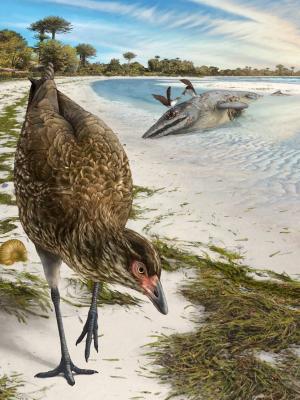
Asteriornis evolved much later on the dinosaur tree—very late in the Cretaceous period—or just before the doomsday asteroid struck the Earth 66 million years ago, wiping out 70% of all living species. Dr. Field dated the skull he found to 66.7 million years old. The first dinosaur is considered to be the Eoraptor, who came along early in the Triassic period about 231 million years ago.
It’s important to know that a wide variety of birds descended from the dinosaurs. And many different types flew among the much larger and familiar dinosaurs like T. rex. But only a few of these birds made it through the extinction event. The Wonderchicken survived the cataclysmic blast from the asteroid to become today’s chickens—but how?
First, it was small. This gave it more mobility and it could also reproduce faster. Second, Asteriornis could fly, giving it a wider range to find food and escape predators. Third, the small bird had a beak, allowing it to break open hard food sources. Finally, its feathers would have given some insulation as our planet cooled significantly after the initial blast inferno from the asteroid impact.
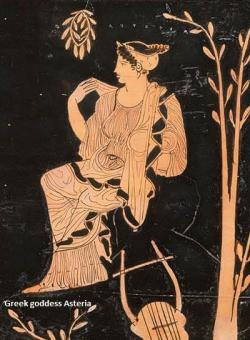 On a cosmic note: The Asteriornis name mirrors both the falling asteroid and the ancient bird’s likeness to today’s fowl. Asteriornis is derived from Asteria, a Titan Greek goddess of falling stars who turns into a quail. Ornis is defined as the birds of a particular time or place. The story goes that after the fall of the Titans, Zeus chased Asteria across the sky. She escapes his clutches by transforming herself into a quail. She then leaps into the sea and turns into the island of Delos.
On a cosmic note: The Asteriornis name mirrors both the falling asteroid and the ancient bird’s likeness to today’s fowl. Asteriornis is derived from Asteria, a Titan Greek goddess of falling stars who turns into a quail. Ornis is defined as the birds of a particular time or place. The story goes that after the fall of the Titans, Zeus chased Asteria across the sky. She escapes his clutches by transforming herself into a quail. She then leaps into the sea and turns into the island of Delos.
Come see our new DinoSOARS! Planetarium program starting February 18, 2022.
The Cat's Eye Nebula
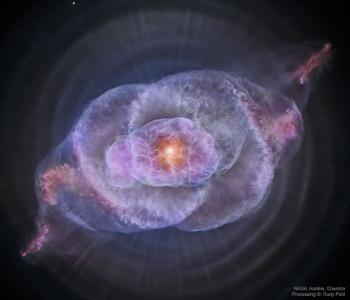 This new image of the Cat’s Eye Nebula was recently released by NASA. It combines powerful pictures from Chandra Observatory X-Ray telescope and the Hubble Space telescope. Some might call it a cosmic conch shell or maybe some sort of distant alien Cyclops. It’s a “planetary” nebula, an expanding gas cloud expelled by the slow death of a star. They are misnamed because when the nebulae were first detected, they looked like planets.
This new image of the Cat’s Eye Nebula was recently released by NASA. It combines powerful pictures from Chandra Observatory X-Ray telescope and the Hubble Space telescope. Some might call it a cosmic conch shell or maybe some sort of distant alien Cyclops. It’s a “planetary” nebula, an expanding gas cloud expelled by the slow death of a star. They are misnamed because when the nebulae were first detected, they looked like planets.
It is located in the constellation Draco the Dragon and is about 3,300 light years from Earth.
Sky Sights
Click maps to enlarge.
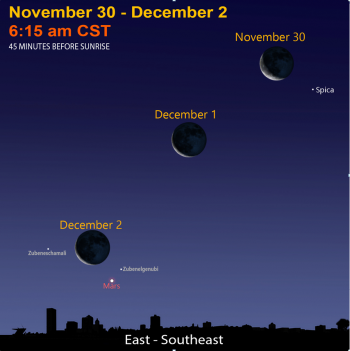 December starts early with the waning crescent Moon passing the bright blue star Spica and then red Mars from November 30 to December 2. The red planet is very low and will be difficult to see. Look about 45 minutes before sunrise in the ESE sky.
December starts early with the waning crescent Moon passing the bright blue star Spica and then red Mars from November 30 to December 2. The red planet is very low and will be difficult to see. Look about 45 minutes before sunrise in the ESE sky.
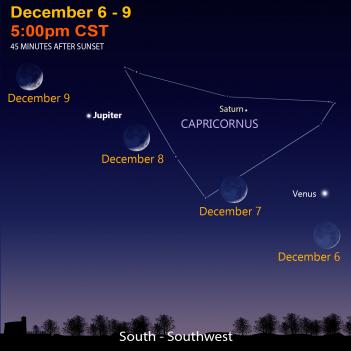 Brave the cold early night and catch the Moon passing in front of Venus, Saturn, and Jupiter from December 6-9.
Brave the cold early night and catch the Moon passing in front of Venus, Saturn, and Jupiter from December 6-9.
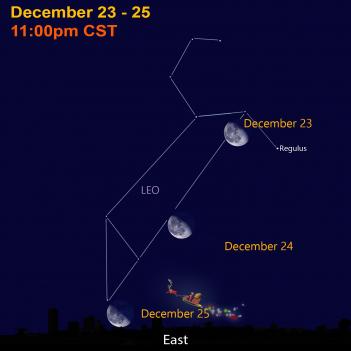 Watch the Moon move through the stars of Leo the Lion from December 23-25. Leo rises a bit late at the start of winter. However, by the start of March, Leo rises as the sun sets and is a star sign for the start of spring!
Watch the Moon move through the stars of Leo the Lion from December 23-25. Leo rises a bit late at the start of winter. However, by the start of March, Leo rises as the sun sets and is a star sign for the start of spring!
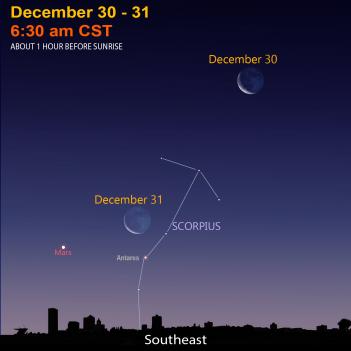 Mars is now a little higher in the SE sky before sunrise and should be easier to spot. The red planet is joined by a red star, Antares, in the constellation Scorpius. Use the waning crescent Moon as your guide to find the red cosmic beacons on December 30-31 about one hour before sunrise.
Mars is now a little higher in the SE sky before sunrise and should be easier to spot. The red planet is joined by a red star, Antares, in the constellation Scorpius. Use the waning crescent Moon as your guide to find the red cosmic beacons on December 30-31 about one hour before sunrise.
_0.jpg) On the last day of the year, little Mercury joins Venus, Saturn, and Jupiter.
On the last day of the year, little Mercury joins Venus, Saturn, and Jupiter.
December Star Map
Sign Up
Receive this newsletter via email!
Subscribe
See the Universe through a telescope
Join one of the Milwaukee-area astronomy clubs and spot craters on the Moon, the rings of Saturn, the moons of Jupiter, and much more.
Follow Bob on social media
Twitter: @MPMPlanetarium
Facebook: Daniel M. Soref Planetarium

